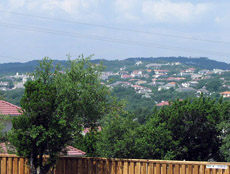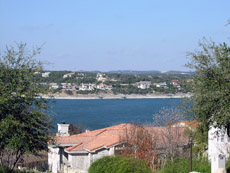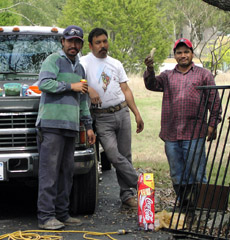Austin sprawl

Houses filling the hills

Development along the shore of Lake Travis

Santa lounging outside a suburban Austin home

Mexican construction laborers working at a suburban home
When I first began visiting Austin, Texas, in the early 1970s, the town of two thousand inhabitants that my parents had retired to was twenty-some miles northwest from the center of the city, on two-lane roads that wound through hilly ranch country. Austin has sprawled. The retirement town on Lake Travis became a bedroom suburb of ten thousand, projected to rise to fifty. The two-lane road past my parents' town is now eight wide miles of commercial strip with twelve different banks and a string of small shopping centers. The chamber of commerce office is moving its office from the small shopping area in the town to the strip at the edge of town.
The town has only two entrance roads off the commercial strip; this gives a feeling of security but congests traffic. The roads to Austin are five and six lanes speeding past development after development, each with its own wall, golf course, amenity package, and clichéed name. Houses have gotten larger; traffic can be intense. The nearby old town of Bee Cave, Texas, once a few wooden stores and restaurants at a highway intersection, is becoming a big box power center.
This sprawl was set off when residents in the town and neighboring unincorporated areas seceded from an original rural school district and set up their own. With the prospect of better schools, the tax base developed rapidly as developers bought up ranch land and where necessary found ways to get around or to deal with restrictions some environmental groups were trying to impose for the sake of water and local habitat. Sprawl would have come sooner or later; Austin was attracting people who wanted suburban living.
The result carpets the hills with houses in whatever styles have been current over the past thirty years: Texas farm houses, Spanish homes, and lately arches and gables. Cul-de-sacs are plentiful and sidewalks few. Garden apartment complexes crowd the hills closer in to the city. Little municipalities have arisen to defend their property values and push costs off onto others. Speed limits and zoning requirements vary abruptly over short segments of road. Public transportation is nonexistent; the auto rules. Roads get bigger, new highways are planned, built, elevated on stilts, but the congestion continues.
Older residents bemoan the loss of country living. Newer residents come not for country life but for an attractive convenient suburb by the lake. No one is happy with local stores closing, the landscape filling up, but they like the conveniences. Mexican maids and construction workers commute in from south Austin suburbs twenty-five miles away. Downtown Austin -- which has a rich urban life of its own -- becomes a destination for special events; there is no shopping need that cannot be met in the local strip or in the large malls half-way to the city.